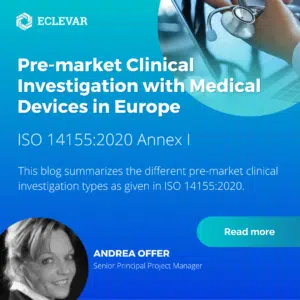Pre-market Clinical Investigation with Medical Devices in Europe as per ISO 14155:2020
Introduction
Last week, ECLEVAR posted a blog about the response to the TGA Consultation on, the 17th of August 2022 on proposed regulatory changes for clinical trials of medical devices [Regulatory changes for clinical trials of medical devices (eclevarmedtech.com)], linking to ISO 14155:2020 and FDA Guidance for Industry: Investigational Device Exemptions (IDEs) for Early Feasibility Medical Device Clinical Studies, Including Certain First in Human (FIH) Studies of October 1st, 2013.
The definitions provided by ISO 14155:2020 Annex I and the FDA Guidance, are almost identic, whereas the FDA Guidance provides further guidance on the differences between early feasibility and traditional feasibility studies.
This blog summarizes the different pre-market Clinical Investigation types as given in the ISO 14155:2020.
Pre-market Clinical Investigations as per ISO 14155:2020
With the updated ISO 14155:2020, the ISO incorporates a new Annex I, on the clinical development stages. Next to the regulatory status of the device at the timepoint of the clinical investigation, pre-market and post-market status, ISO 14155:2020 groups the CIs also depending on the clinical development stage, the type of design, the descriptors of the clinical investigation, and the burden to subjects.
Under the pre-market clinical investigations, ISO 14155:2020 Annex I divides clinical investigations into pilot stage and pivotal stage.
Regarding the burden on subjects, any pre-market clinical investigation is considered to be interventional.
Clinical Development Stage and Type of Design
In the pre-market status, the clinical investigations are either the pilot stage or the pivotal stage. The type of design may be explanatory or confirmatory.
Identifiers for exploratory clinical investigations are, that they “might not have pre-specified primary hypotheses, and can be conducted to generate hypotheses, to be confirmed in subsequent clinical investigations.”
A confirmatory clinical investigation is “an adequately controlled clinical investigation in which the hypotheses of the primary endpoint(s) are stated before the start of the clinical investigation in the CIP and are analysed by the CIP (i.e. sound confirmative statistical testing is pre-specified, intended, and applied).”
Which clinical investigations would be considered pilot stage?
The pilot stage clinical investigations can be exploratory or confirmatory.
These can be:
- I.5.2 First in human clinical investigations: “A clinical investigation in which a medical device for a specific indication is evaluated for the first time in human subjects.”
- I.5.3 Early feasibility investigations: “A limited clinical investigation of a device early in development, typically before the device design has been finalized, for a specific indication (e.g. innovative device for a new or established intended use, marketed device for a novel clinical application). It can be used to evaluate the device design concept concerning initial clinical safety and device clinical performance or effectiveness (if appropriate) as per intended use in a small number of subjects when this information cannot practically be provided through additional nonclinical assessments or appropriate nonclinical tests are unavailable. Information obtained from an early feasibility clinical investigation can guide device modifications. An early feasibility clinical investigation does not necessarily involve the first clinical use of a device.
- NOTE Early feasibility clinical investigation can also be called proof of concept clinical investigation.”
- I.5.4 “Traditional feasibility investigations: A clinical investigation that is commonly used to capture preliminary clinical performance, effectiveness, or safety information of a near-final or final device design to adequately plan an appropriate pivotal clinical investigation. Because the clinical investigation of a near-final or final device design takes place later in development than an early feasibility clinical investigation, more non-clinical or prior clinical data are expected than in an early feasibility clinical investigation. A traditional feasibility clinical investigation does not necessarily need to be preceded by an early feasibility clinical investigation.”
Which clinical investigations would be considered a pivotal stage?
The pivotal stage clinical investigations are only confirmatory clinical investigations:
- I.5.5 “Pivotal clinical investigation: A confirmatory clinical investigation designed to collect data on the clinical performance, effectiveness, or safety of a device for a specified intended use, typically in a statistically justified number of human subjects. It can or cannot be preceded by an early and/or a traditional feasibility clinical investigation.”
Link to MDR 2017/745 Articles
To close the loop of the process it is needed to refer to MDR 2017/745 for the selection of the correct CI submission route. The principle of ISO 14155:2020 Annex I to clinical investigations as per MDR 2017/745 Art. 62 and Art. 74.2, some of the Art. 82 other clinical investigations, but also to Article 74.1 PMCF Clinical Investigations.
- Article 62: General requirements regarding clinical investigations conducted to demonstrate the conformity of devices– considered pre-market stage
- Article 74.2: Clinical investigations regarding devices bearing the CE marking – outside the scope of its intended purpose – considered pre-market stage
- Article 74.1 PMCF clinical investigations fall under the post-market stage, although the confirmatory design and interventional aspects need to be taken into account for planning these studies also.
- Article 82: Requirements regarding other clinical investigations, if:
- It is an interventional clinical investigation with a CE-marked or non-CE marked device, but not for purposes of Art. 62.1 (example: CE marked Stent, investigation to explore the impact on blood flow; non-CE marked smart monitoring device, investigation to explore changes in the behavior of subjects when using the device)
- It would not apply to Art. 82 clinical investigations with CE-marked devices within the scope of intended use and without any additional burden to the subject, as these fall under the post-market stage (observational)
References
- ISO 14155:2020 Clinical investigation of medical devices for human subjects — Good clinical practice
- FDA Guidance for Industry: Investigational Device Exemptions (IDEs) for Early Feasibility Medical Device Clinical Studies, Including Certain First in Human (FIH) Studies of October 1st, 2013.
- REGULATION (EU) 2017/745 OF THE EUROPEAN PARLIAMENT AND OF THE COUNCIL of 5 April 2017 on medical devices, amending Directive 2001/83/EC, Regulation (EC) No 178/2002 and Regulation (EC) No 1223/2009 and repealing Council Directives 90/385/EEC and 93/42/EEC
- MDCG 2021-6: Regulation (EU) 2017/745 – Questions & Answers regarding clinical investigation, April 2021
Thank you for your time, and interest. ECLEVAR MedTech posts regularly on topics related to Medical Devices and IVDs – Regulatory, Clinical, Medical Writing, in Australia, the EU, the UK, and the USA.
Check-out for our next interesting blog.
ECLEVAR MEDTECH is a global CRO, headquartered in Paris. We support medical device and IVD manufacturers in the MDR and IVDR transition. Our team works as an extension team of medical affairs and regulatory affairs sponsors. We offer customized service, personalized to the need of our clients. Whether you are looking for a full-service CRO or staffing clinical or regulatory experts, our management team with more than 20 years of experience will drive you to an effective solution Please contact us at clientcare@eclevar.com to learn more.

